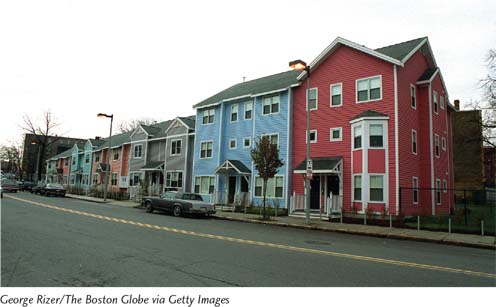working toward  sustainability
sustainability
What Are the Ingredients for a Successful Neighborhood?
The Dudley Street area of Roxbury and North Dorchester in Boston was once a prime example of urban blight. In the 1980s, years of urban decay and the loss of large numbers of primarily Caucasian families to the suburbs had left 21 percent of the Dudley Street neighborhood vacant—
Eminent domain A principle that grants government the power to acquire a property at fair market value even if the owner does not wish to sell it.
In 1984, residents banded together to turn their neighborhood around. They formed the Dudley Street Neighborhood Initiative (DSNI), designed to allow the residents to move toward a common vision for a sustainable neighborhood. Participants chose a large board of directors—
By 1987, DSNI had worked with community members to develop a comprehensive revitalization plan, which has been periodically updated since then. The main goals of the DSNI plan are
to rehabilitate existing housing.
to construct homes that are affordable according to criteria set by residents.
to assemble parcels of vacant land for redevelopment, using the power of eminent domain if necessary.
 The Dudley Street neighborhood. This neighborhood in Boston, Massachusetts, was once a symbol of urban decay. Today it is a thriving urban community that has adopted many of the principles of smart growth.(George Rizer/The Boston Globe via Getty Images)Page 351
The Dudley Street neighborhood. This neighborhood in Boston, Massachusetts, was once a symbol of urban decay. Today it is a thriving urban community that has adopted many of the principles of smart growth.(George Rizer/The Boston Globe via Getty Images)Page 351to plan environmentally sound, affordable development that is physically attractive.
to convert some vacant properties into safe play areas, gardens, and facilities that the entire community can enjoy.
to run a full summer camp program for area children.
to develop strong public and private partnerships to ensure the economic vitality of the neighborhood.
to increase both the economic and political power of residents.
DSNI has had many successes. Its first major action was to force the city to remove trash, appliances, and abandoned cars that littered the streets and vacant lots. The city also cleaned up two illegal dumps in the area. Residents planted community gardens to grow produce and flowers. DSNI successfully reduced drug dealing in the neighborhood park, although keeping the drug dealers out remains a constant struggle. And, perhaps most significantly, its work led to the construction of 300 new homes on formerly vacant lots. New residents help to add vitality to the neighborhood, reversing the cycle of depopulation and business closure.
It is evident that the individuals involved in DSNI have taken many of the principles of smart growth to heart. The community mixes residential with retail development, and residents live within walking distance of a grocery store, ethnic markets, and other amenities. Moreover, since the founding of DSNI, two small manufacturing businesses—
The Dudley Street neighborhood still has relatively low per capita income, and its development choices have not been without controversy. However, it serves as one example of hundreds of neighborhoods that have begun to turn the positive feedback loop of urban decay into one of urban renewal and hope.
Critical Thinking Questions
What are some of the features of a community that will make it sustainable?
How has the Dudley Street neighborhood engaged in “smart growth”?
List and describe three ideas for “smart growth” in your own community.
References
Bernfield, F. K., J. Terris, and N. Vorsanger. 2003. Solving Sprawl: Models of Smart Growth in Communities Across America. Island Press.
Dudley Street Neighborhood Initiative. http:/